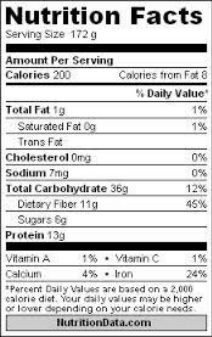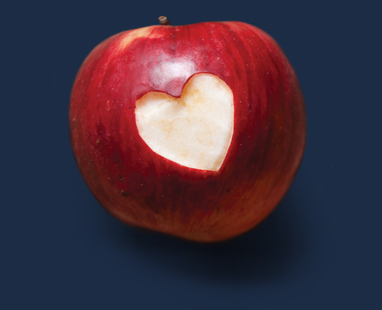Boost your Consumer IQ – How to Read Nutrition Labels
Grocery shopping can be confusing!
Grocery shopping can be confusing! It seems like every day there are new shout-outs on packaged foods: Heart Healthy! High in Protein! Trans-fat Free! What does it all really mean? In order to know what value a packaged food provides, understanding nutrition labels really helps. Nutrition facts are based on the Dietary Guidelines and on “Percent Daily Value” (PDV). You’ll see that the values are listed as a percentage, and this percentage is based on a 2,000-calorie-a-day intake. However, you may not eat 2,000 calories a day, so the percentage of the nutrients you consume would be higher or lower.
My regular readers and clients know that I’m all about eating foods that don’t come with a food label at all! However, for those times when we must buy packaged food, it is important to first read the ingredients list (see my article on reading Ingredients Lists on my Blog ). When you do buy a packaged product, I recommend foods with five ingredients or less – all of which you should be able to pronounce!. Foods with five ingredients or less are typically minimally-processed and contain lower amounts of sodium, sugar, “bad” fats, or chemicals than the ‘multi-ingredient’ distant cousins do.

That said, here are my top tips for How to Read a Nutrition Label:
Serving Size. The amount of nutrients in the food is provided PER SERVING SIZE. So if your bottle of juice says it contains two servings sizes, drinking the whole bottle means you will have consumed twice the amount of everything listed on the label. And trust me, some foods that you would think should only be a single serving are often listed as two servings!
Calories are defined as the amount of “energy” a food provides. In my health coaching practice, I don’t focus on calories, but rather, I encourage clients to eat nutrient-dense foods and avoid nutrient-deficient foods. This is because not all calories are created equal; counting them can lead you to make unhealthy choices and develop an unhealthy relationship between you and your food. Food provides information to your cells. Some food promotes health, gives you energy and makes you feel satisfied, while other foods promote disease, sap your energy, increase your blood sugar, and can actually make you feel hungry. According to Dr. Mark Hyman, Chairman of the Functional Medicine Institute “there’s no such thing as ‘junk food;’ there’s “food” and there’s “junk” and it doesn’t matter how many calories “junk” has.” The bottom line is: pay more attention to the ingredients than the calories listed on the package.
Fat and Cholesterol The FDA requires that fat on the nutrition label be categorized as saturated fat, trans-fat, polyunsaturated, and monounsaturated fat. According to the CDC, “Diets high in saturated fat have been linked to coronary heart disease.” I recommend that you avoid saturated fats and that you eat no trans-fats! (The clue that a food contains trans-fat is the listing of “partially hydrogenated oil” on the ingredients list). While the FDA removed trans-fats from the Safe Food List in 2006, companies are still able to call their products “trans-fat free” even if their total is 0.5 g or less per serving!
Sodium is one of my least favorite ingredients after artificial sweeteners, sugar and trans-fats! Too much salt increases the risk of heart disease and high blood pressure. The American Heart Association encourages limiting sodium intake to 1500 mg a day – that is less than one teaspoon! Pay attention to sodium totals for the foods you buy and aim for reduced-sodium or no-sodium products whenever possible. I encourage my clients to switch to himalayan pink sea salt which is known to contain over 80 minerals and our body needs all of them.
Total carbohydrates are listed as fiber and sugar. Like calories, not all carbohydrates are created equal. According to Dr. Mark Hyman, it is the type of carbohydrates that is most important. “If the carbohydrates are from whole-plant foods that contain plenty of fiber or have a low Glycemic Load, that is very different (better) than that of fiber-less foods. The same number of carbohydrates from a can of beans or from a can of Coke affects the body in very different ways.” When choosing products, go for healthy fiber that is whole-plant based.
Sugar is listed in grams; I recommend that my clients do not eat foods that contain added sugar or artificial sweeteners. Sugar is an addictive substance that can be very harmful; it creates inflammation in the body, runs down the immune system, causes insulin resistance, and can lead to weight gain and disease. Look for products with low or no grams of sugar listed on the nutrition label.
Protein is listed per serving. The Daily Value for protein is 50 grams, but again, your recommended amount depends on many factors. I encourage clients to get their protein from high-quality sources such as beans, nuts, fish, chicken, quinoa, etc.
Vitamins A and C amounts are required to be listed by the FDA. However, you will find that many nutrition labels include other nutrients and their amounts per serving. Again, this is based on a 2,000-calorie-per-day diet, so the percentage of vitamins you consume may vary. It is always best to get these vitamins from foods that don’t actually come in a package! Vegetables and fruit are your best sources of vitamins.
Sources: FDA Backgrounder: The New Food Label; Dr. Mark Hyman


